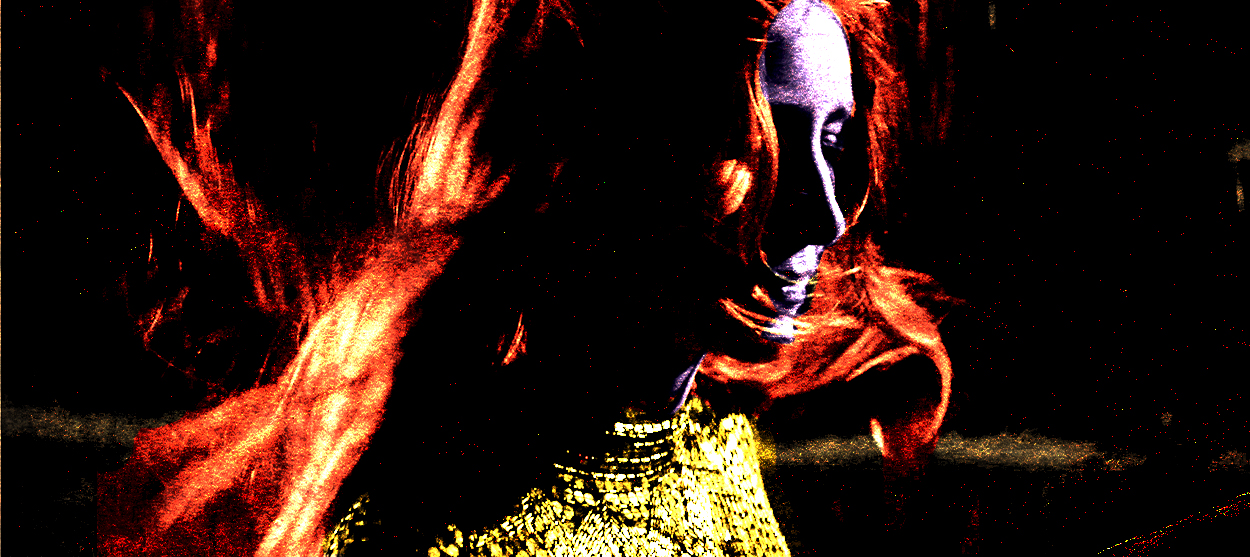A visual analysis of Game of Thrones' stunning 'Battle of the Bastards,' in 37 images
Here's why everyone can't stop talking about director Miguel Sapochnik's visual masterpiece

There's a lot to praise in the direction and cinematography of Game of Thrones' latest episode, "Battle of the Bastards," but to me, one of the most fascinating choices was also — compared to dragons, dying giants, and the agonizing, almost expressionist footage of Jon suffocating — rather subtle.
I'm talking about the formal parallels between these two shots in which the Stark siblings go rogue — on different-colored horses and facing opposite directions. Sansa leaves the parley and rides away from Boltons and Starks alike after telling Ramsey to sleep well since he'll be dying tomorrow. (Is she riding off to get Littlefinger? It's unclear, cf. the Sansa Problem.) The next day we see Jon in the same location doing the same thing, but riding the other way.
[[{"type":"media","view_mode":"media_large","fid":"157433","attributes":{"alt":"","class":"media-image","height":"337","typeof":"foaf:Image","width":"600"}}]](Screenshot/HBO/Game of Thrones)
The Week
Escape your echo chamber. Get the facts behind the news, plus analysis from multiple perspectives.

Sign up for The Week's Free Newsletters
From our morning news briefing to a weekly Good News Newsletter, get the best of The Week delivered directly to your inbox.
From our morning news briefing to a weekly Good News Newsletter, get the best of The Week delivered directly to your inbox.
[[{"type":"media","view_mode":"media_large","fid":"157434","attributes":{"alt":"","class":"media-image","height":"335","typeof":"foaf:Image","width":"600"}}]](Screenshot/HBO/Game of Thrones)
That's obviously a small detail given an episode chock-full of rich, gorgeously rendered action, but it's worth noting — one of the pleasures of brilliant direction is the beauty of its grace notes. Director Miguel Sapochnik did so much to evoke the psychological horrors of battle. There's the whiplash produced by the cinematic contrast between the perfect geometries of Ramsey's forces and the chaos they create:
[[{"type":"media","view_mode":"media_large","fid":"157514","attributes":{"alt":"","class":"media-image","height":"340","typeof":"foaf:Image","width":"600"}}]](Screenshot/HBO/Game of Thrones)
[[{"type":"media","view_mode":"media_large","fid":"157515","attributes":{"alt":"","class":"media-image","height":"336","typeof":"foaf:Image","width":"600"}}]](Screenshot/HBO/Game of Thrones)
A free daily email with the biggest news stories of the day – and the best features from TheWeek.com
[[{"type":"media","view_mode":"media_large","fid":"157527","attributes":{"alt":"","class":"media-image","height":"339","typeof":"foaf:Image","width":"600"}}]](Screenshot/HBO/Game of Thrones)
[[{"type":"media","view_mode":"media_large","fid":"157528","attributes":{"alt":"","class":"media-image","height":"336","typeof":"foaf:Image","width":"600"}}]](Screenshot/HBO/Game of Thrones)
[[{"type":"media","view_mode":"media_large","fid":"157529","attributes":{"alt":"","class":"media-image","height":"337","typeof":"foaf:Image","width":"600"}}]](Screenshot/HBO/Game of Thrones)
[[{"type":"media","view_mode":"media_large","fid":"157530","attributes":{"alt":"","class":"media-image","height":"325","typeof":"foaf:Image","width":"600"}}]](Screenshot/HBO/Game of Thrones)
One of the pleasures of this contrast is that both the chaos and the clean lines are stunning — and the former is much harder to pull off:
[[{"type":"media","view_mode":"media_large","fid":"157516","attributes":{"alt":"","class":"media-image","height":"335","typeof":"foaf:Image","width":"600"}}]](Screenshot/HBO/Game of Thrones)
[[{"type":"media","view_mode":"media_large","fid":"157526","attributes":{"alt":"","class":"media-image","height":"344","typeof":"foaf:Image","width":"600"}}]](Screenshot/HBO/Game of Thrones)
[[{"type":"media","view_mode":"media_large","fid":"157518","attributes":{"alt":"","class":"media-image","height":"340","typeof":"foaf:Image","width":"600"}}]](Screenshot/HBO/Game of Thrones)
[[{"type":"media","view_mode":"media_large","fid":"157519","attributes":{"alt":"","class":"media-image","height":"342","typeof":"foaf:Image","width":"600"}}]](Screenshot/HBO/Game of Thrones)
[[{"type":"media","view_mode":"media_large","fid":"157520","attributes":{"alt":"","class":"media-image","height":"333","typeof":"foaf:Image","width":"600"}}]](Screenshot/HBO/Game of Thrones)
[[{"type":"media","view_mode":"media_large","fid":"157521","attributes":{"alt":"","class":"media-image","height":"340","typeof":"foaf:Image","width":"600"}}]](Screenshot/HBO/Game of Thrones)
Speaking of aesthetics, I want to note what, for me, were the two most viscerally jarring moments of the episode because they were stylistically so perfectly opposed. The first is the unforgettably beautiful image of Jon assuming his position in front of the charging cavalry (oh, that music) when he faces being trampled to death the first time:
[[{"type":"media","view_mode":"media_large","fid":"157452","attributes":{"alt":"","class":"media-image","height":"338","typeof":"foaf:Image","width":"600"}}]](Screenshot/HBO/Game of Thrones)
The second is the blurry footage of the moments when he actually was:
[[{"type":"media","view_mode":"media_large","fid":"157536","attributes":{"alt":"","class":"media-image","height":"333","typeof":"foaf:Image","width":"600"}}]](Screenshot/HBO/Game of Thrones)
[[{"type":"media","view_mode":"media_large","fid":"157537","attributes":{"alt":"","class":"media-image","height":"332","typeof":"foaf:Image","width":"600"}}]](Screenshot/HBO/Game of Thrones)
[[{"type":"media","view_mode":"media_large","fid":"157538","attributes":{"alt":"","class":"media-image","height":"332","typeof":"foaf:Image","width":"600"}}]](Screenshot/HBO/Game of Thrones)
It's basically a series of blotches, of lights and darks, and it's totally different from all the beautiful footage of the rest of the battle. It is horrifying and exquisite:
[[{"type":"media","view_mode":"media_large","fid":"157539","attributes":{"alt":"","class":"media-image","height":"337","typeof":"foaf:Image","width":"600"}}]](Screenshot/HBO/Game of Thrones)
[[{"type":"media","view_mode":"media_large","fid":"157540","attributes":{"alt":"","class":"media-image","height":"335","typeof":"foaf:Image","width":"600"}}]](Screenshot/HBO/Game of Thrones)
But for all that, what interested me most about Sapochnik's direction was how virtuosically he multiplied the horrors of archery — and how he used archery to bracket the battle's larger story. Bows and arrows are frequently the tool of choice for good guys in fiction (hi Hunger Games) because of the skill it requires and its precision, but Sapochnik alternately renders arrows as highly targeted deliverers of death and — on the other hand — terrifying and constant and arbitrary. The transition happens slowly and takes three slightly different approaches — before taking one last cathartic approach. Let's walk through them.
1. This arrow has your name on it.
Think of how distance functions before the battle, how endless the space between the two armies feels while Rickon is running toward Jon. Our impression is that he'll never cross that expanse (and indeed he doesn't).
[[{"type":"media","view_mode":"media_large","fid":"157490","attributes":{"alt":"","class":"media-image","height":"339","typeof":"foaf:Image","width":"600"}}]](Screenshot/HBO/Game of Thrones)
The shift from this kind of overhead shot — which to us registers as an impossible distance, that's why it's so awful — to Ramsey aiming is fairly typical. It makes him feel all-powerful:
[[{"type":"media","view_mode":"media_large","fid":"157492","attributes":{"alt":"","class":"media-image","height":"338","typeof":"foaf:Image","width":"600"}}]](Screenshot/HBO/Game of Thrones)
Then there's the close-up of the arrows — those low-tech weapons we associate with heroes and nobler civilizations that modernity trampled into the ground.
[[{"type":"media","view_mode":"media_large","fid":"157493","attributes":{"alt":"","class":"media-image","height":"346","typeof":"foaf:Image","width":"600"}}]](Screenshot/HBO/Game of Thrones)
By the middle of the battle, arrows will have become technological nightmares, basically drones. But right now we're building momentum. They're still single, specific. The biggest fake-out in the direction came when the camera lingered on Ramsey taking what looked like the fatal shot. Our depth of field literally narrows here: The bit in focus slowly moves forward, from Ramsey's psychopathic face to the arrow's tip.
[[{"type":"media","view_mode":"media_large","fid":"157497","attributes":{"alt":"","class":"media-image","height":"334","typeof":"foaf:Image","width":"600"}}]](Screenshot/HBO/Game of Thrones)
[[{"type":"media","view_mode":"media_large","fid":"157491","attributes":{"alt":"","class":"media-image","height":"332","typeof":"foaf:Image","width":"600"}}]](Screenshot/HBO/Game of Thrones)
The music swells, everything tightens, and the arrow lands harmlessly near Rickon's feet.
The brilliance of this sequence is that despite all that buildup, when Rickon dies, the arrow just appears. It somehow crossed that huge distance — made bigger by cuts and sound and crisis — instantaneously. It is, for all intents and purposes, a bullet.
2. Arrows as death rain.
Collapsing or expanding our sense of distance in order to maximize psychological horror, this technique peaks in the beautiful shot that tracks the arrows from the Bolton archers all the way up and over to their Stark targets.
[[{"type":"media","view_mode":"media_large","fid":"157435","attributes":{"alt":"","class":"media-image","height":"332","typeof":"foaf:Image","width":"600"}}]](Screenshot/HBO/Game of Thrones)
[[{"type":"media","view_mode":"media_large","fid":"157436","attributes":{"alt":"","class":"media-image","height":"334","typeof":"foaf:Image","width":"600"}}]](Screenshot/HBO/Game of Thrones)
[[{"type":"media","view_mode":"media_large","fid":"157437","attributes":{"alt":"","class":"media-image","height":"337","typeof":"foaf:Image","width":"600"}}]](Screenshot/HBO/Game of Thrones)
[[{"type":"media","view_mode":"media_large","fid":"157438","attributes":{"alt":"","class":"media-image","height":"333","typeof":"foaf:Image","width":"600"}}]](Screenshot/HBO/Game of Thrones)
[[{"type":"media","view_mode":"media_large","fid":"157439","attributes":{"alt":"","class":"media-image","height":"337","typeof":"foaf:Image","width":"600"}}]](Screenshot/HBO/Game of Thrones)
[[{"type":"media","view_mode":"media_large","fid":"157440","attributes":{"alt":"","class":"media-image","height":"337","typeof":"foaf:Image","width":"600"}}]](Screenshot/HBO/Game of Thrones)
It's immensely artistic and hugely effective. It gives us yet another angle on their relative positions on the battlefield, and it produces the particular panic things coming from above tend to evoke (see: Dany's dragons). If Rickon's death collapsed our sense of distance from the enemy, there's at least a certain relief in a death you don't see coming. This shot dispenses with that cold comfort: It stretches the arrow's time to target just slightly. These arrows may take a little longer than Ramsey's lethal shot — you can track them with your eyes — but they're all the more horrifying because of it. Worse, somehow, they're not even aimed at you in particular. Any lingering association between fair play and archery dissolves.
3. Arrows as arbitrary.
Then of course there's this complementary pairing: Jon, whom every arrow misses, finds himself at the beginning of the battle in roughly the same position the poor giant Wun Wun will assume at the end. Wun Wun, who seems to absorb every single arrow that should have landed on his commander. Wun Wun, at whom the archers shot, like Saint Sebastian, "till he was as full of arrows as an urchin":
[[{"type":"media","view_mode":"media_large","fid":"157444","attributes":{"alt":"","class":"media-image","height":"334","typeof":"foaf:Image","width":"600"}}]](Screenshot/HBO/Game of Thrones)[[{"type":"media","view_mode":"media_large","fid":"157446","attributes":{"alt":"","class":"media-image","height":"335","typeof":"foaf:Image","width":"600"}}]](Screenshot/HBO/Game of Thrones)
[[{"type":"media","view_mode":"media_large","fid":"157506","attributes":{"alt":"","class":"media-image","height":"337","typeof":"foaf:Image","width":"600"}}]](Screenshot/HBO/Game of Thrones)
This is terror in another form: that the arrows which at first seemed precise and then seemed arbitrary could attack one target so relentlessly while leaving another untouched.
4. Arrows becoming ineffective.
A lot of digital ink has been spilled on how to manufacture dread and how to conjure horror, but it's worth thinking just as hard about how you exit that space — how, after trampling you under the weight of men and corpses, a director helps you up and back to sanity. Wun Wun's awful death notwithstanding, the healing work of the episode is how it reverses this course of terror we've been on.
Consider the fact that Wun Wun withstands the rain of arrows: He's injured, possibly dying, but he is alive. What follows is a sort of reprise of Rickon's death: Wun Wun's death comes suddenly, from a perfect shot to the eye:
[[{"type":"media","view_mode":"media_large","fid":"157508","attributes":{"alt":"","class":"media-image","height":"335","typeof":"foaf:Image","width":"600"}}]](Screenshot/HBO/Game of Thrones)
His death, like Rickon's, is instant. And we discover that Ramsey was the source:
[[{"type":"media","view_mode":"media_large","fid":"157509","attributes":{"alt":"","class":"media-image","height":"337","typeof":"foaf:Image","width":"600"}}]](Screenshot/HBO/Game of Thrones)
It's a perfect bookend to the beginning of the battle, when Ramsey taunted Jon into an insane rage by killing someone he loved in front of him. And it undoes its horror by collapsing the distance that made it so uncannily chilling. Ramsey's final encounter with Jon is too close for arrows. Ramsey's perfect archery fails. His power collapses up close, and his inability to kill Jon is frankly therapeutic. Jon's incredible blocking ability trumps Ramsey's incredible aim, and this shot of those stymied arrows does a lot to salve our jangled nerves.
[[{"type":"media","view_mode":"media_large","fid":"157510","attributes":{"alt":"","class":"media-image","height":"338","typeof":"foaf:Image","width":"600"}}]](Screenshot/HBO/Game of Thrones)
What's more, it's a Mormont shield; Jon is literally saved by his allies. Little Lady Lyanna Mormont has done her part.
Lili Loofbourow is the culture critic at TheWeek.com. She's also a special correspondent for the Los Angeles Review of Books and an editor for Beyond Criticism, a Bloomsbury Academic series dedicated to formally experimental criticism. Her writing has appeared in a variety of venues including The Guardian, Salon, The New York Times Magazine, The New Republic, and Slate.
-
 Walter Isaacson's 'Elon Musk' can 'scarcely contain its subject'
Walter Isaacson's 'Elon Musk' can 'scarcely contain its subject'The latest biography on the elusive tech mogul is causing a stir among critics
-
 Welcome to the new TheWeek.com!
Welcome to the new TheWeek.com!The Explainer Please allow us to reintroduce ourselves
-
 The Oscars finale was a heartless disaster
The Oscars finale was a heartless disasterThe Explainer A calculated attempt at emotional manipulation goes very wrong
-
 Most awkward awards show ever?
Most awkward awards show ever?The Explainer The best, worst, and most shocking moments from a chaotic Golden Globes
-
 The possible silver lining to the Warner Bros. deal
The possible silver lining to the Warner Bros. dealThe Explainer Could what's terrible for theaters be good for creators?
-
 Jeffrey Wright is the new 'narrator voice'
Jeffrey Wright is the new 'narrator voice'The Explainer Move over, Sam Elliott and Morgan Freeman
-
 This week's literary events are the biggest award shows of 2020
This week's literary events are the biggest award shows of 2020feature So long, Oscar. Hello, Booker.
-
 What She Dies Tomorrow can teach us about our unshakable obsession with mortality
What She Dies Tomorrow can teach us about our unshakable obsession with mortalityThe Explainer This film isn't about the pandemic. But it can help viewers confront their fears about death.


